outer_limits
Hazard to Others
  
Posts: 139
Registered: 3-3-2020
Member Is Offline
Mood: hybridized
|
|
Copper bromide from copper sulphate
I thought about making some copper(II) bromide from copper sulphate and potassium bromide.
What I found - copper(II) bromide is soluble in acetone.
Copper sulphate, potassium sulphate an potassium bromide is not.
I thought that if I would dump KBr and CuSO4 to water then I will get a mix of ions in solution. After that I would add acetone - insoluble compounds
will precipitate and I will get some CuBr2 remaining in solution. After few iterations I could get the most of bromide.
Am I correct and such easy approach would work?
[Edited on 13-8-2020 by outer_limits]
|
|
|
macckone
International Hazard
    
Posts: 2159
Registered: 1-3-2013
Location: Over a mile high
Member Is Offline
Mood: Electrical
|
|
Mixed solvent systems are tricky to predict.
That is where experimentation comes in.
You might want to try microscale before using a bunch of reagents.
Go forth and do chemistry.
|
|
|
outer_limits
Hazard to Others
  
Posts: 139
Registered: 3-3-2020
Member Is Offline
Mood: hybridized
|
|
And I'm going to try it now 
|
|
|
outer_limits
Hazard to Others
  
Posts: 139
Registered: 3-3-2020
Member Is Offline
Mood: hybridized
|
|
Ok, chemistry is done and here are the results
1 gram of CuSO4 *5H2O (4 mmol) and 0.95 grams of KBr (8 mmol) were dissolved in 15 ml of distilled water. Then 20 ml of acetone was added. The
solution changed color - from blue/green to green, black and light blue.
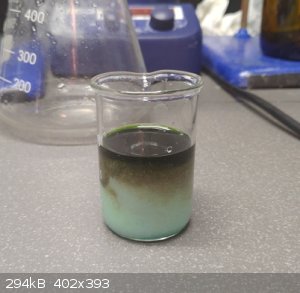
Precipitate was filtered and washed 3 times with acetone. The solid on filter was pale blue. After first washing it changed color to dark green. After
each of washings the color became lighter.
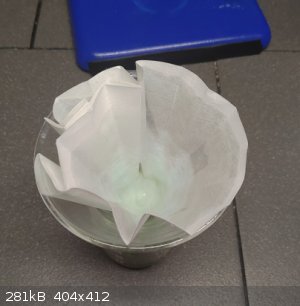
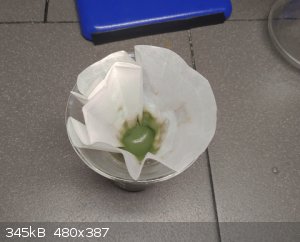
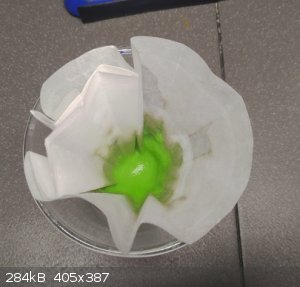
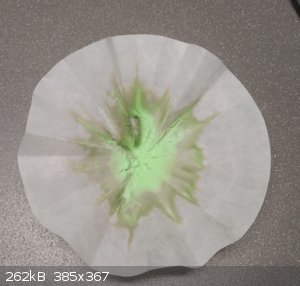
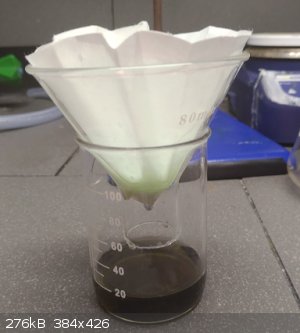
Extraction was repeated giving pale blue precipitate on filter and clean filtrate.
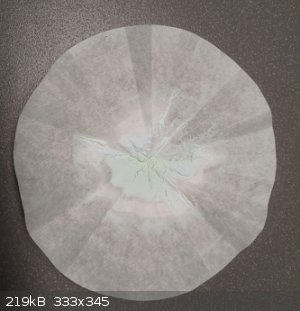
Combined extracts were evaporated to dryness. During evaporation formation of white crystals was observed.
Finally, 0.7 grams of black crude product with some minor green impurities was isolated giving the yield of 78.65%
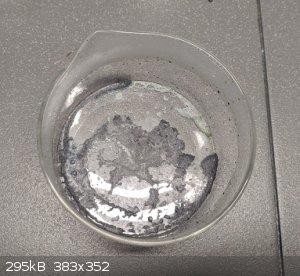
[Edited on 13-8-2020 by outer_limits]
|
|
|
Fery
National Hazard
   
Posts: 990
Registered: 27-8-2019
Location: Czechoslovakia
Member Is Offline
|
|
Cu2+ also forms complex with Br-
CuO + 2 HBr is another way to go https://www.sciencemadness.org/whisper/viewthread.php?tid=15...
The route using acetone extraction seems to be promising too, thank you for your report.
[Edited on 13-8-2020 by Fery]
|
|
|
DraconicAcid
International Hazard
    
Posts: 4278
Registered: 1-2-2013
Location: The tiniest college campus ever....
Member Is Offline
Mood: Semi-victorious.
|
|
Any white crystals you get are going to be potassium salts. Copper(II) with bromide ligands is going to be dark, dark, dark.
Please remember: "Filtrate" is not a verb.
Write up your lab reports the way your instructor wants them, not the way your ex-instructor wants them.
|
|
|
outer_limits
Hazard to Others
  
Posts: 139
Registered: 3-3-2020
Member Is Offline
Mood: hybridized
|
|
There were no white crystals in final product. After evaporation everything was black with some green impurities
This is how the filter looked 30 minutes after filtration
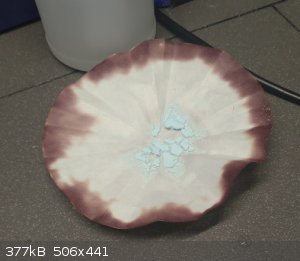
[Edited on 13-8-2020 by outer_limits]
|
|
|
Maurice VD 37
Hazard to Self
 
Posts: 66
Registered: 31-12-2018
Member Is Offline
|
|
Sorry to puzzle you. But Copper(II) bromide is black and deliquescent. Copper(I) bromide is white and insoluble in water. Your nearly colorless
product is probably copper(I) bromide, which has been formed spontaneously, a little bit like copper(II) iodide, which does not exist and
spontaneously gets decomposed according to :
2 Cu2+ + 4 I- --> 2 CuI + I2
|
|
|
outer_limits
Hazard to Others
  
Posts: 139
Registered: 3-3-2020
Member Is Offline
Mood: hybridized
|
|
The final product is black as you can see in crystallisation dish.
The thing on filter is a precipitate that contains some of Cu ions. It's not the product
[Edited on 13-8-2020 by outer_limits]
|
|
|
outer_limits
Hazard to Others
  
Posts: 139
Registered: 3-3-2020
Member Is Offline
Mood: hybridized
|
|
This is the product yielded from extraction
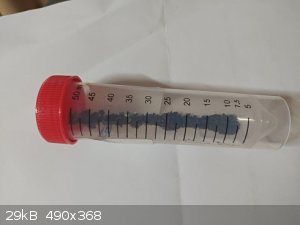
That's right, this is probably better way to go and I think I will make more copper bromide using HBr and oxide.
I was curious if it will succeed.
And lazy 
[Edited on 13-8-2020 by outer_limits]
|
|
|
macckone
International Hazard
    
Posts: 2159
Registered: 1-3-2013
Location: Over a mile high
Member Is Offline
Mood: Electrical
|
|
outer_limits,
Congrats on the successful synthesis.
78% is really good for a simple synthesis where you know going in you aren't going to get 100% conversion.
|
|
|
outer_limits
Hazard to Others
  
Posts: 139
Registered: 3-3-2020
Member Is Offline
Mood: hybridized
|
|
It seems that it failed and I get a complex instead of pure CuBr2.
I've checked the solubility by putting some of this black powder to the test tube and adding the water. It forms a white suspension but it should be
soluble in water. Addition of H2O2 changed the colour of solution to brown, there was a small stain of brownish material on the test tube which looked
like metallic copper.
|
|
|
Chemi Pharma
Hazard to Others
  
Posts: 349
Registered: 5-5-2016
Location: Latin America
Member Is Offline
Mood: Quarantined
|
|
Quote: Originally posted by outer_limits  | It seems that it failed and I get a complex instead of pure CuBr2.
I've checked the solubility by putting some of this black powder to the test tube and adding the water. It forms a white suspension but it should be
soluble in water. Addition of H2O2 changed the colour of solution to brown, there was a small stain of brownish material on the test tube which looked
like metallic copper.
|
Sorry to puzzle you too @outer limits, but with the reaction you did you will not get CuBr2 (gray powder, hygroscopic). Try CuO + HBr like other
members said. Copper sulfate + alkali bromide just produce complex and a little portion of CuBr (Cu+1). I just have a video about that reaction, just
adding a few grams of granulated copper to get quite pure CuBr (white solid, water insoluble) (Cu+1, not Cu+2). You can see that video made by
@myst32YT at this You Tube link: https://www.youtube.com/watch?v=EafB5dq_MFY
|
|
|
outer_limits
Hazard to Others
  
Posts: 139
Registered: 3-3-2020
Member Is Offline
Mood: hybridized
|
|
That's right, Hbr + CuO is way to go.
Anyway, it was a nice small experiment
|
|
|
woelen
Super Administrator
        
Posts: 7976
Registered: 20-8-2005
Location: Netherlands
Member Is Online
Mood: interested
|
|
What you made is impure CuBr. Acetone reduces the copper(II) to copper(I). You precipitate CuBr, which is white like snow (but pale blue, due to some
remaining Cu(2+)). CuBr, when humid, is very air-sensitive and is easily oxidized to dark green basic oxybromide of copper(II). This product is
ugly-looking and hard to obtain in a precise stoichiometric ratio between Cu, Br and O.
CuBr2 is a dark grey solid, looking somewhat like iodine, also with the same lustre. The hydrate is dark green. When this compound is dissolved in a
very small amount of water, the solution is very dark brown/red/purple, but on dilution the solution turns green and on further dilution the solution
turns sky-blue, like a dilute solution of CuSO4. The brown/red/purple ion is a bromo-complex of copper(II), the green ion is a mixed hydrate/bromo
complex of copper(II), and the blue ion is a purely hydrated copper(II) ion.
|
|
|
DraconicAcid
International Hazard
    
Posts: 4278
Registered: 1-2-2013
Location: The tiniest college campus ever....
Member Is Offline
Mood: Semi-victorious.
|
|
Quote: Originally posted by woelen  | | What you made is impure CuBr. Acetone reduces the copper(II) to copper(I). You precipitate CuBr, which is white like snow (but pale blue, due to some
remaining Cu(2+)). |
Acetone acting as a reducing agent? What does it get oxidized to?
Please remember: "Filtrate" is not a verb.
Write up your lab reports the way your instructor wants them, not the way your ex-instructor wants them.
|
|
|
Lion850
National Hazard
   
Posts: 514
Registered: 7-10-2019
Location: Australia
Member Is Offline
Mood: Great
|
|
I tried to make CuBr2 by doing a double displacement between copper sulphate pentahydrate and CaBr2. The hydrate of the CaBr2 was unknown but probably
the hexahydrate.
20g of copper sulfate was dissolved in 100g of near boiling water giving a blue solution. 20g of calcium bromide was dissolved in 40g of room temp
water. This should have put the copper sulphate in excess, assuming the calcium bromide to be the hexahydrate.
I slowly added the CaBr2 solution to the very hot CuSO4 solution and stirred. I expected white calcium sulphate to precipitate out and the solution to
turn dark. As the calcium bromide mixed with the copper sulphate I did see some black but it soon all became a green mixture. And quite thick. See
photo. I wondered if I ended up with copper i bromide CuBr instead, and poured it into a plastic container to increase the contact area with air, and
see if it will slowly go black. But after a few hours it is still green, but I think I can see some white ppt which should be calcium sulphate.
What happened?
After I poured the contents from the beaker I washed out the last bits of solid and the wash water turned blue! Which is probably due to excess copper
sulphate but what kept the excess ‘clear’ until excess water was added?
I want to try again but with both solutions at room temp and this time I’ll add the CuSO4 to the CaBr2.
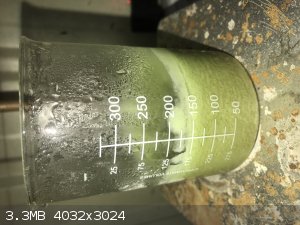 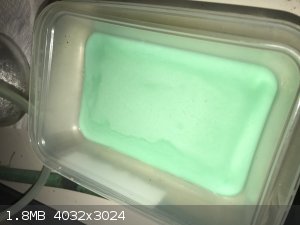
[Edited on 15-8-2020 by Lion850]
|
|
|
AJKOER
Radically Dubious
    
Posts: 3026
Registered: 7-5-2011
Member Is Offline
Mood: No Mood
|
|
Some understanding on the chemistry.
If one starts with a possible CuBr2 (or CuI2), the compound rapidly degrades back to Cuprous (especially in the presence of light). The Cu(+) in the
presence of O2 and H+ will form a basic salt:
4 Cu(+) (aq) + O2 + 2 H+ (aq) -> 4 Cu(++) (aq) + 2 OH- (aq)
The presence of a halide here also acts as a complexing agent creating a soluble cuprous for the above reaction to proceed.
My cited chemistry (absence the complexing part) is in accord with Woelen comment:
"CuBr, when humid, is very air-sensitive and is easily oxidized to dark green basic oxybromide of copper(II). "
|
|
|
woelen
Super Administrator
        
Posts: 7976
Registered: 20-8-2005
Location: Netherlands
Member Is Online
Mood: interested
|
|
I have noiticed with acetone that it is quite easily oxidized when it is mixed with moderately strong inorganic oxidizers. I do not know to what it is
oxidized, but I know from experience that the inorganic material is reduced. E.g. copper(II) is converted to copper(I), manganese(VII) is converted to
manganese(IV). For that reason I do not really like the use of acetone for salting out things or as a solvent for certain chemical reactions. It is
fine though for really non-oxidizing inorganics.
|
|
|
Lion850
National Hazard
   
Posts: 514
Registered: 7-10-2019
Location: Australia
Member Is Offline
Mood: Great
|
|
A few posts up I mentioned attempting a double displacement between copper sulphate and calcium bromide and getting a mix of green solution and white
ppt. Update:
I added the previous green liquid and white ppt mix to 400ml water and brought to boil for a while. This was then vacuum filtered. The ppt (presumably
calcium sulphate) was mainly off-colored white, with some black in the white after drying on a steam bath; see photo.
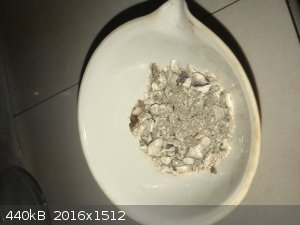
The filtrate was a lovely deep green. See photo of the filtrate being boiled down.
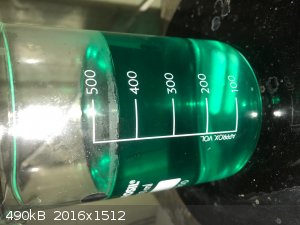
As the volume reduced, a suspension started to be visible at around 250ml. AT 200ml I stopped boiling, let the suspension settle, decanted the
supernatant green liquid and transferred the wet pale blue suspension to a crucible.
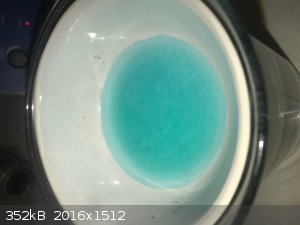
The crucible was placed on the steam bath. The light blue suspension dried out to black crystals. See photo of the black crystals in a bottle.
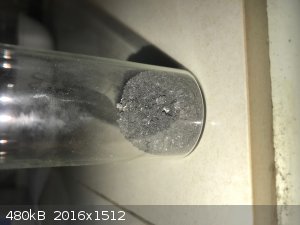
The black crystals dissolved very easy in water, almost in an instant! They give a pale blue solution, see photo. Similar color to before drying out.
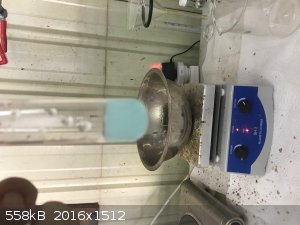
I added a few drops of silver nitrate solution to the pale blue solution. A ppt immediately forms. This ppt looks more black in the mainly fluorescent
light in my shed, but in the light from the phone flash it looks off white! See photos. I have never seen such a distinct change in appearance
depending on light.
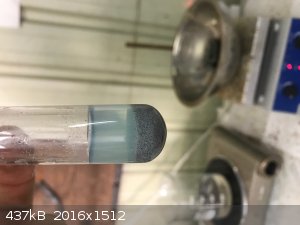 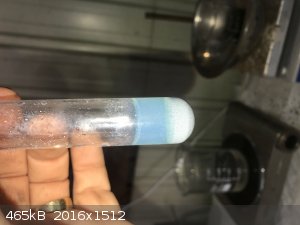
So, is this copper ii bromide? The anhydrous color (black) as well as hydrated color (blue-ish) seems correct from what I read online, and the ppt
with silver nitrate looks similar to when I mix silver nitrate with potassium bromide...but only in the light from the flash!
Edit: I forgot to say the remainder of the green solution that was decanted is giving a second crop of black crystals, a larger volume and more
difficult to get bone dry. Drying continues.
[Edited on 18-8-2020 by Lion850]
|
|
|
Lion850
National Hazard
   
Posts: 514
Registered: 7-10-2019
Location: Australia
Member Is Offline
Mood: Great
|
|
Update on my previous post: the second crop of black crystals was weighed at 15g, the first crop was 3, so total 18g. Which matches well with the the
stoichiometry.
I dropped some concentrated sulphuric acid on some of the crystals expecting to see a lot of bromine vapors, as happens when sulphuric acid is dropped
on potassium iodide. There was some vapor, but it soon stopped. I then put a gram or so with concentrated sulphuric acid in a small beaker and heated
it up; with hot H2SO4 it did produce a lot or orange-ish vapor with strong chlorine-like smell.
So as far as I can tell my CuBr2 is less reactive with sulphuric acid than KBr - is this normal?
|
|
|
woelen
Super Administrator
        
Posts: 7976
Registered: 20-8-2005
Location: Netherlands
Member Is Online
Mood: interested
|
|
I think that the black crystals indeed are CuBr2 (anhydrous), but fairly impure, with CaSO4 mixed in as well. This makes drying easier and the final
product does not give completely clear solutions in water. The second crop, which dries with more difficulty, most likely is purer CuBr2, with less
CaSO4 in it.
I see no direct explanation for the black-looking precipitate. Silver ions give a white precipitate with bromide. Apparently, there also is some
reducing species, which leads to formation of black elemental silver.
The fact that with the flash the precipitate almost looks white can be explained. There are many very fine particles in the precipitate and in the
intense light of the flash, the scattered light leads to overexposure and the fine division leads to a whiter appearance. I expect that if you take a
picture from a greater distance and adjust the exposure parametwers, such that the lighting is correct at the precipitate, then it will look darker.
Now the lighting is fairly correct at every place in the picture, except at the precipitate.
|
|
|
outer_limits
Hazard to Others
  
Posts: 139
Registered: 3-3-2020
Member Is Offline
Mood: hybridized
|
|
Finally, I made it. I had to synthesize HBr. Then I made CuO from CuSO4 by reacting it with KOH. After that CuBr2 was produced by reacting CuO with
HBr.
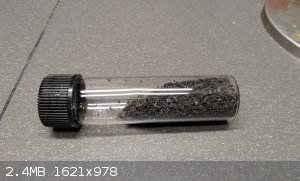
|
|
|